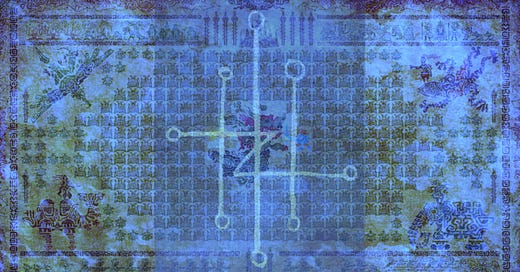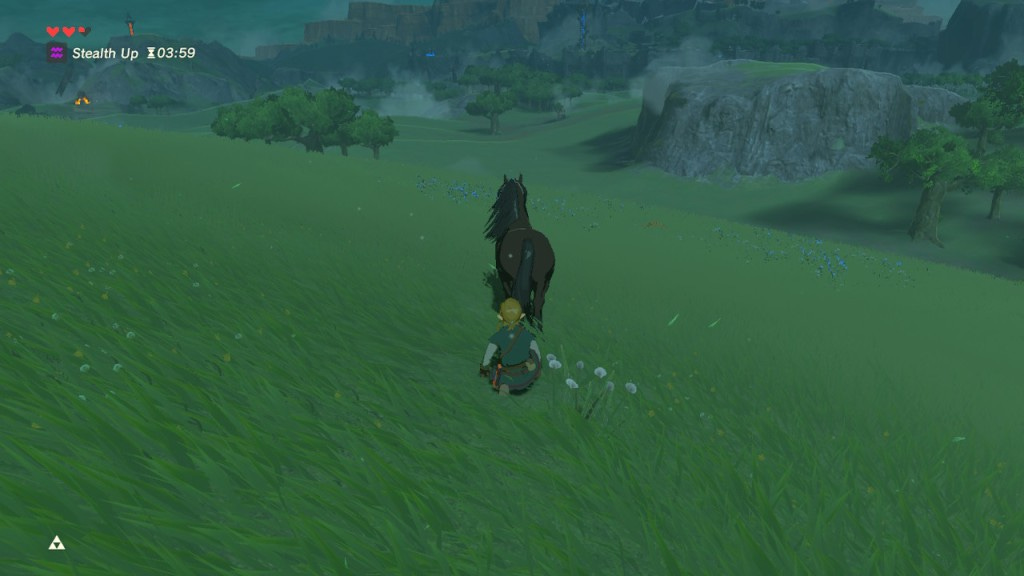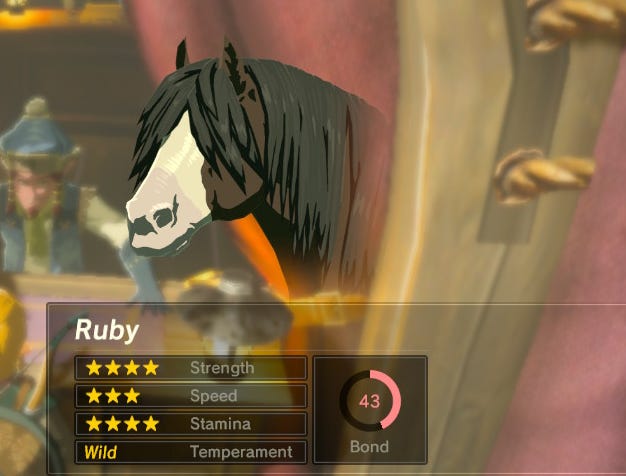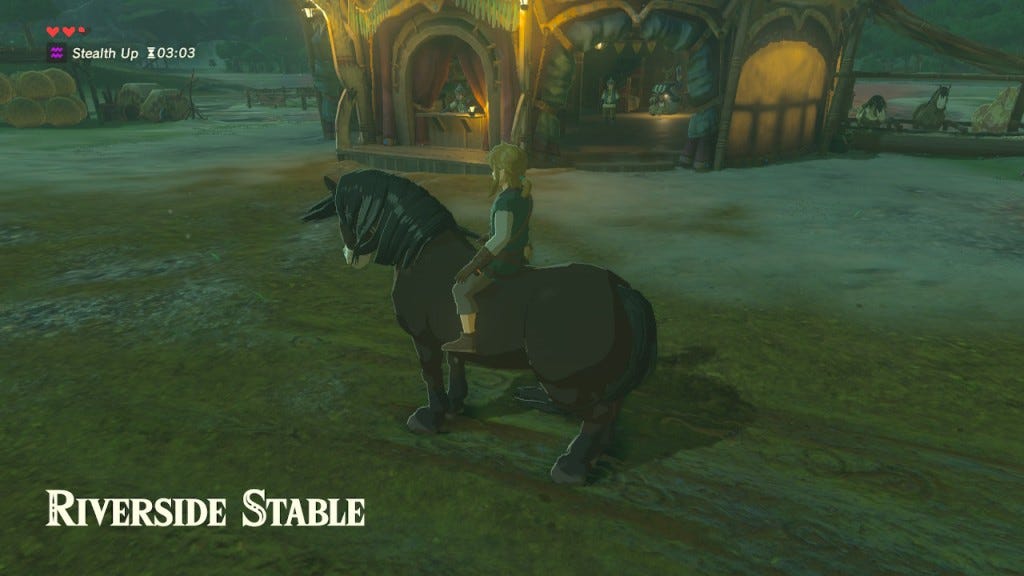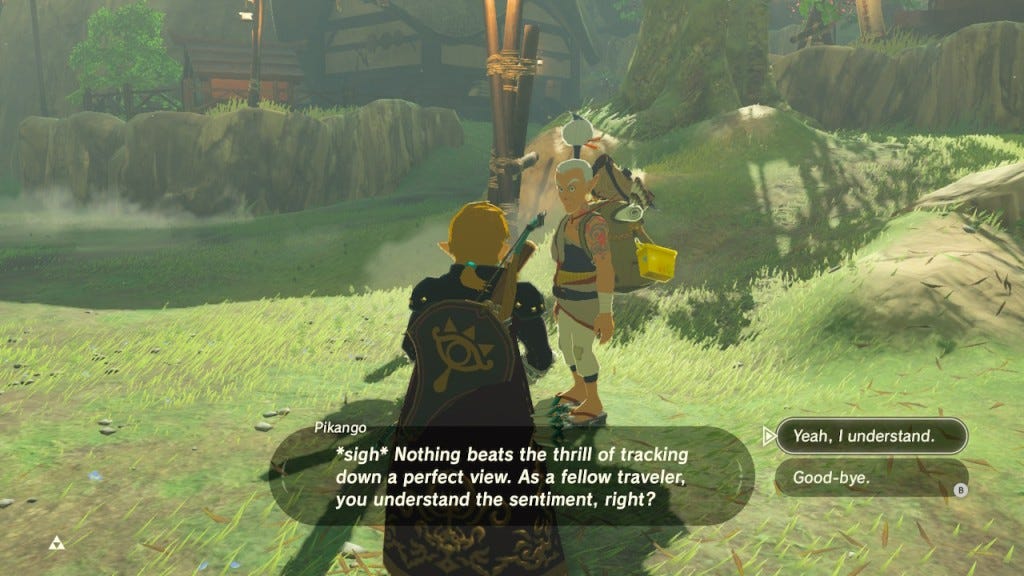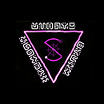The Hero's Journey is a whole lot of "hurry up and wait;" that's not only a recurring theme in the game Breath of the Wild, it's a recurring theme on the actual Hero's Journey. Earlier, at the top of the Great Plateau Sheikah Tower, Zelda called out to Link from Hyrule Castle, weakening in her 100 years' battle to keep Calamity Ganon from re-emerging into the world long enough for Link to get his shit together and strike Ganon down once and for all; she told him specifically, "Hurry...before it's too late." Next thing Link knows, he's at the bottom of the tower taking shit from The Old Man about being in such a hurry, and more than this, he's subjected to a protracted trial that seems designed, in part, specifically to teach the lesson of patience. I could just be projecting, of course. I do know that patience was a lesson I took from The Great Plateau the second time through, when I intentionally made it a point to thoroughly explore the place before I left. The rewards? Well, one of the other recurring themes in this game is the fact that exploration is its own reward. However, one of the things I want to convey most in this post is the difference—in the experience, the context, and the possibilities—between the first playthrough and subsequent playthroughs. That's because, in this post, I will be getting much more explicit about something I've previously only hinted at: The concept of Digital Initiation.
Horsing Around
Warning! SPOILERS for The Legend of Zelda: Breath of the Wild from here on out!
I have to confess to some hesitance to Crossing the First Threshold, both literally in-game, figuratively in the general scheme of The Hero's Journey, and symbolically on...countless personal levels. To any readers who are personally familiar with the territory of esoteric Initiation, the hints I've been dropping have probably grown noticeably in pitch as our story has progressed. Well, just as Link now faces a steep drop before him, the ground is about to fall out beneath my own feet in Initiatory terms. Just as Link stands above a three-way crossroads representing three fateful directions, I can see many personal (and collective) roads converging from my current vantage point just above them. Like Link, it's not the drop that's so intimidating: He's got a paraglider, and I've got a similar framework for taking in a bird's eye view of this all when needed. Like Link, I really just need to get some practice in and build up the Stamina I need to fly this thing into my future. Like Link, the thing that really gives me pause is the sheer scope of what I see before me. The Kingdom of Hyrule is huge, just look at it! He has directions to follow, but still and all, he's got to know his quest is gargantuan in scope. We, as the player of the game, most certainly know our journey will eventually require us to cover all this ground. I can remember from my first playthrough that even with a map marker, the "mere" journey from The Great Plateau (which we do learn later, is relatively trivial once Link gets properly situated) was more challenging than I anticipated.
The aforementioned emphasis on exploration in an initial playthrough of this game was one of the strongest factors: The entire Kingdom of Hyrule is just as well-designed as The Great Plateau, replete with eye-catching distractions to pull us off of our course, thoughtful rewards for following those inclinations that encourage the player to keep doing that, and a whole lot of sheer artistic beauty. Hyrule begs Link to get lost in its peaks and valleys, its folds and crevices, its streams and forests; and yet—the player with a keen eye for certain patterns will be especially aware of it—as immersive and disorienting as Hyrule can be, this land is also perfectly designed so that no matter what Link does, he just seems to find ways of advancing his Hero's Journey and coming one step closer to achieving his goal. He is as free as is humanly possible, while being just restricted enough at every twist and turn that there is still some reward to be had from continuing on. This aesthetic "sweet spot" is the Holy Grail of open world games. This will be a delicate matter, as it includes both objective and subjective elements, so opinions will certainly vary, but standards can still be set. Anyway, this game was the first game to claim that Holy Grail in my eyes.
By sheer coincidence, there are similar "sweet spots" to Initiatory and magic(k)al systems and they run along pretty much the same lines.
Now that I'm playing through a certain opening stretch of this game for the 4th or 5th time, it's really funny to see just how much of the scenery and ambiance is scripted; one couldn't be so sure the first time around, and there is a lot that does fall into more random experiential patterns. But I've grown happily accustomed to seeing the same fox just outside Bosh Kala Shrine, with its trial, The Wind Guides You, as I pass by. There's another place where this difference becomes highly apparent, and discovering it has now altered the course of my game. I used to follow the "East" path, between Dueling Peaks, which would eventually take me past Dueling Peaks stable; that's normally my first horse stable. On my first playthrough, that's where I got my first horse. It's clearly intended to be the first stable you reach on your first playthrough (just after you make a sharp left turn to head from East to North), because it's right on the path upon which you were sent, and it also has a quest centered around catching and taming a wild horse; other stables don't have this quest.
Horse taming is so randomized that it's touted as a whole entire feature of the game unto itself, almost a minigame. Horses roam in teams in various parts of Hyrule. There are patterns (horses with different stat priorities tend to spawn at certain places), but the horses all have different coat colors and patterns, and different stat ratings (Strength, Speed, Stamina, etc.).
On this playthrough, I am taking a shortcut that I only noticed because I took the time to stand there and really investigate the "launch pad" between the two eagles on The Great Plateau (which I explore in this post). "If it's not to go pick up Majora's Mask," I asked myself, "where does this middle pathway 'want' me to go?" And it didn't take me long to realize it, because following that road for a while and then continuing in its general direction eventually leads to the stable where, I've learned, my favorite horse has spawned reliably every time I've gone there. It's usually got a solid cinnamon coat (though once I caught a black one instead, even though it still had the same stats).
The stable is called Riverside Stable, which has some personal meaning to me that I will get into in an upcoming post. As luck would have it, this post will actually segue narratively right into that one.
So, I realized there's a nice, reliable way to go grab a horse right out the gate and get going—no muss, no fuss, no guesswork. Good. This is the stuff plans are made of, and I am definitely going to need one.
I can look back and realize why this hadn't occurred to me on previous playthroughs. In this case, "Hyrule Field," a wide open space occupying the heart of the map of Hyrule, is very aptly named because in my experience, it's almost as though there was a huge "force field" around it at first. Let's be realistic, Hyrule Castle is pretty close to the only good reason to be there at all; it's crawling with Guardians, which are large, swift, almost octopus-like robotic sentries with a very powerful explosive laser attack. So there's that. But there's one other thing we're going to get a view on soon: The placement of all the other objectives, which tends to flow more along the edges/corners of the map relative to Hyrule Field.
I've also realized that from Riverside Stable (where my toon is currently parked), it's a pretty quick shot (once you know the way) to Kakariko's side entrance, which I almost never used at all before. On a first playthrough, you probably won't spot it on the map and if you do, the actual view of that area will be discouraging: It looks like a big, mountainous slope to climb, with no clear reward. The terrain is a bit deceiving. It looks entirely different from the top, from where you can see the slope is much smoother and more forgiving; in other words, totally rideable, and it will shave time off the trip if it just so happens that your specific objectives for a given playthrough involve stopping there just long enough to clear the quest objective with Impa and be on your way. That won't be my routine this time around.
Birds Of A Feather
Kakariko Village is an unassuming little town with great purpose. It isn't just some cowtown; Kakariko is the home in Hyrule of the Sheikah Clan. Think of the Sheikah as a bit of a cross between a mystic order of knights and a ninja clan; their sole purpose is to serve the Goddess Hylia and the Royal Family of Hyrule. As we will learn, it was in fact they who built the mysterious towers that rose up at the beginning of the game, as well as the Sheikah Shrines; they built the Sheikah Slate, too, and the Guardians I mentioned earlier. At the moment, Link stands at the center of their purpose, since its other aspects are on hiatus what with the whole Ganon waking up and possessing the Divine Beasts and all.
As we will gradually see, despite the existence of other villages (including the very one where Link can buy a house and set up a home), Kakariko is just about the only place in this world where Link can find authentic connection with a community of his own people and a context for his life, his journey, that fits neatly within some larger context. That's important. There's one other such city, but I'll get to that one near the end of this post; there's technically a third, but it doesn't exist yet, so there's no point discussing it).
When Link arrives in Kakariko and meets with Impa, a new quest chain is started that takes him over to Hateno Village to meet Purah at Hateno Ancient Tech Lab and get his Sheikah Slate fully repaired. Then he's brought back, and given one more quest which I will cover separately; then, he's given the Main Quest (technically optional, oddly): Free the Divine Beasts. At this point, the game opens up even if you've been a good boy scout and followed all of your quest objectives to the letter: Impa marks the beasts on your map and simply sends you on your way.
On my first playthrough, I struggled to find my way at this point. I did a lot of wandering around. The Main Quest felt too big, and I still knew next to nothing about the game. Now, I have a laundry list of stuff to run around and get out of the way before reaching this, another Threshold, where the decision as to how to proceed begins to take on symbolic weight once again.
Just as on The Great Plateau, Link is free to do this however he wants to do it. Just as on The Great Plateau, the terrain and the map both suggest a certain play order. Just as on The Great Plateau, Link is strongly "nudged" toward the first intended Divine Beast, and the rest do sort of flow naturally from there. Unlike The Great Plateau, that flow runs widdershins. This journey will take Link on a path of Elemental Initiation.
There's a Sheikah Shrine up on a cliff; it's pretty conspicuous. If you weren't inclined to go up there on your own, Pikango, a painter you will encounter everywhere you go, has some pointed dialogue that plants the suggestion:
Once you get up there, you'll find a land tower that begs you to climb it. Then, once you do, you'll be so taken by the view that you'll quickly notice there's an even higher viewpoint across the chasm. Go there, and...sigh...just look:
Does this lush valley not simply cry out to be explored? Look, there are two or three easy Sheikah Shrines in clear view; low-hanging fruit, not to be dismissed. Besides, gliding down there from way up here will be the absolute most satisfying flight Link is likely to have seen yet.
I know where I went on my first playthrough.
Before I ride on over there, however, I need to hit the hay at the Riverside Stable Inn; I have a lot to think about. This is not my first time around the block and I have a very ambitious plan forming for the story that is unfolding. Link is about to engage what, for him, must be the difficult prospect of weaving his daunting journey in with the paths of those around him. It was 100 years ago when he died; he doesn't really know anyone in this world he's here to save. Something seems unbalanced about that.
As he begins to nod off, Link resigns himself to the task of rectifying that situation.
Order of Operations
Perhaps my magical readers will have seen where I'm going with some of this (probably a long time ago if they're at all fans of Zelda). Developing a relationship with and a mastery over The Four Elements is a staple of Ceremonial Magic(k); Link's trials and quests related to each of the Divine Beasts will have many parallels to Franz Bardon's Initiation Into Hermetics.
If you look up opinions on the best order in which to complete the Divine Beasts, there are many different takes, which makes sense, because there are different reasons to take into consideration. One of the more likely factors for many players will be the utility of the Champion's Abilities. Briefly, each Divine Beast is rightfully piloted and watched over by one of the Champions of Hyrule. Each of the Champions has a special ability that they bestow upon Link when he frees their respective Beast. They are powerful abilities; some say they are game-breaking. On my first playthrough, I leaned heavily on these abilities and it determined my play order. Now I am good enough at the game that this factor makes zero difference to me.
The idea behind Digital Initiation as a concept is that certain aspects of the traditional Initiatory experience can be conferred or communicated in new ways using new technologies, including and especially virtual reality or gaming. This deserves a focused treatment, but I wanted to bring it up.
My theory is that there is deep significance to the suggested play order. So far, I have followed the first branch of that hunch and found entire rabbit holes unto themselves surrounding the first Divine Beast in the suggested order and the geographical region surrounding it. It also seems meaningful that the Blight Ganon associated with Vah Naboris, the final Divine Beast in the suggested order, is generally considered the most difficult to defeat. I haven't followed this through entirely with the same depth that I've given to Zora's Domain; taking that journey of discovery is the point behind these writings.
As I began revealing in the previous post, I see interesting parallels between Link's journey and my own; I talked about the decision of Hearts vs. Stamina in the light of my teacher's conception of Red Magic and Green Magic. I also see some parallels beginning to form that involve the road we are not taking at present: That left turn from the launchpad, that Royal Road; but we'll cross that bridge when we come to it.


